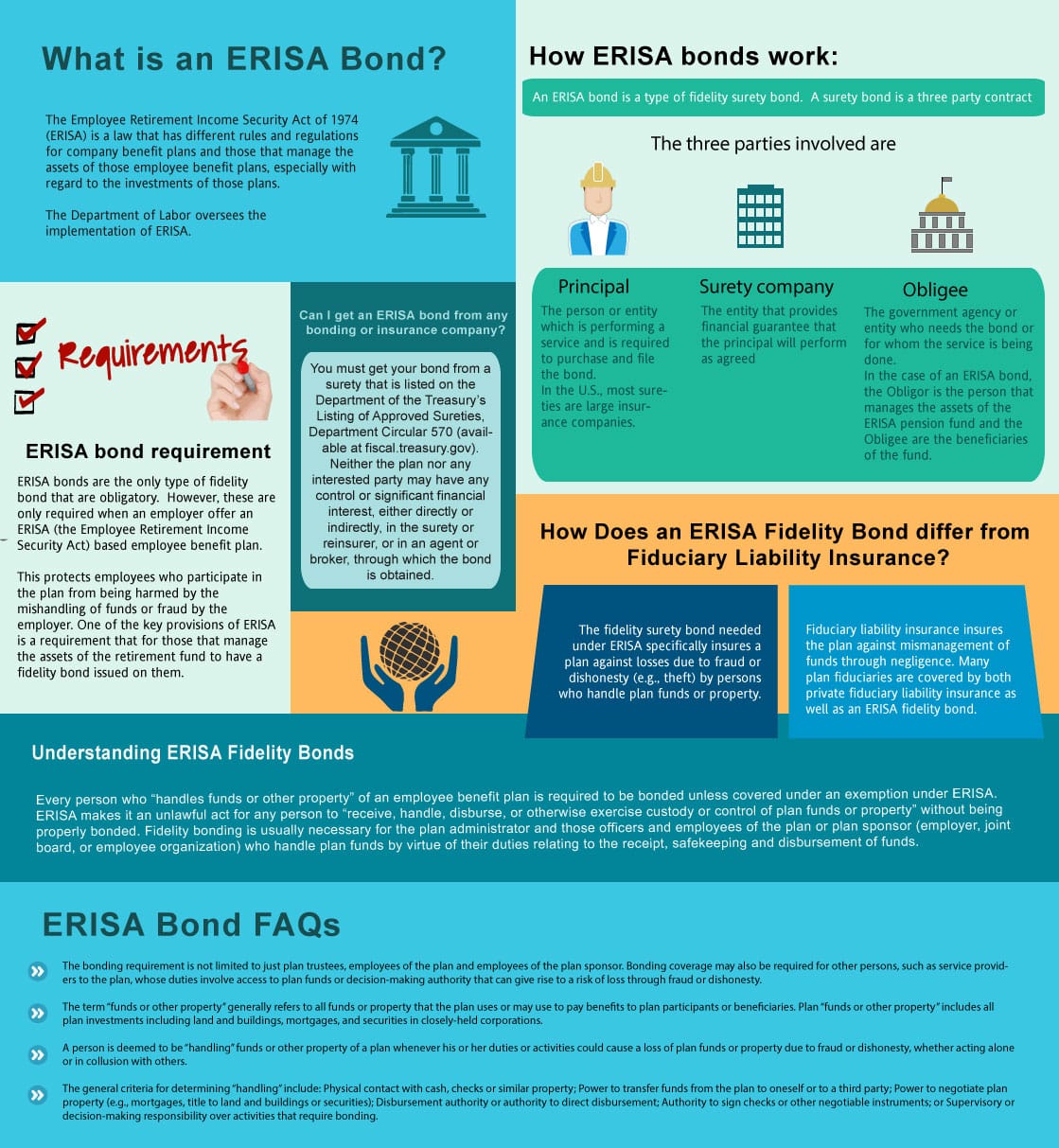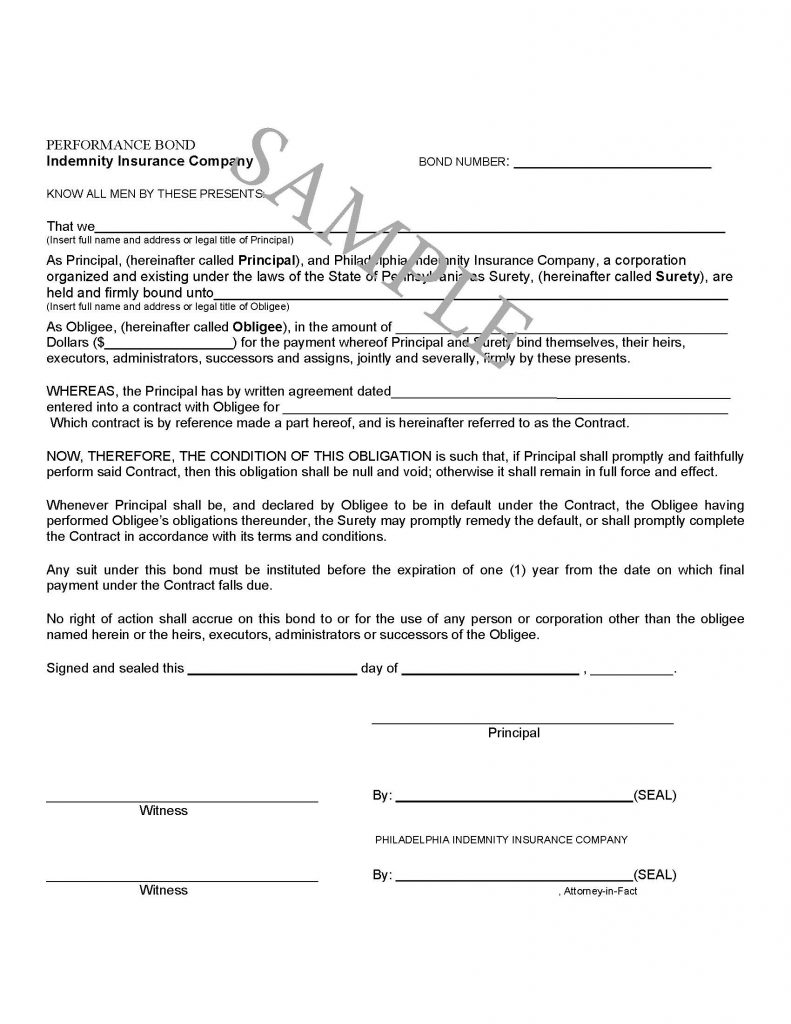

ERISA Bond – Protecting an Employee Benefit Plan
The Employee Retirement Income Security Act of 1974 (ERISA) is a law that has different rules and regulations for company benefit plans and those that manage the assets of those employee benefit plans, especially with regard to the investments of those plans. The Department of Labor oversees the implementation of ERISA. The reason that ERISA was passed if that there was public concern that the retirement ability of employees were being jeopardized due to abuse and mismanagement of employee’s retirement funds.
ERISA Fidelity Bond Quote
| Federal ERISA Bond Form |   | |
| California ERISA Bond |   |

Introduction to ERISA Bonds:
ERISA bonds are an integral component of the company's services in extending the right retirement plans for its employees. These bonds, required by the Employee Retirement Income Security Act (ERISA) of 1974, offer a layer of security to protect the plan from losses due to fraud or dishonesty. There are various types of ERISA bonds, including fidelity bonds, fiduciary liability insurance, and crime insurance.
The requirements for ERISA bonds can vary depending on the intricacy and complexity of the employee benefit plan. Broker services play a significant role in ensuring anyone who handles plan funds or other property is appropriately covered by a fidelity bond. In addition, fiduciaries who hold discretionary power over the plan's assets must also hold a fiduciary liability insurance policy. Crime insurance is another kind of ERISA bond that provides a safety net against losses stemming from theft or fraud by third parties. It is paramount to understand the prerequisites for each type of bond to ensure compliance with ERISA stipulations.
ERISA bonds may come at a price, but they are a small token to guarantee the future. They provide peace of mind to plan sponsors and participants, safe in the knowledge that their assets are sheltered from fraudulent activities. Additionally, having ERISA bonds in place can improve the plan's credibility and reputation, while also making it more appealing to potential contributors. Broadly, ERISA bonds remain a deserving investment for any employer committed to safeguarding their employee benefit plan.
Types of ERISA Bonds
ERISA bonds are a non-negotiable requirement for all employee benefit plans in the United States. These bonds act as a safety measure, protecting the plans from losses due to fraud, dishonesty, or other criminal actions executed by plan officials. Under ERISA, fidelity bonds are divided into three main categories: fidelity bonds, pension plan bonds (employee benefit plan funds), and health and welfare plan bonds.
Fidelity Bonds
Fidelity bonds serve as the most common type of bond for employee benefit plan funds. They shield employee benefit plans from damages due to fraudulent or dishonest acts committed by plan officials or employees. These acts could range from theft, embezzlement, forgery, or other crimes committed about the control of plan funds or property.
Each fidelity bond typically covers every plan official and employee who interacts with plan funds or property, including trustees, administrators, investment managers, and other fiduciaries. In case of any questions regarding the intricacies of these bonds, the company's services extend to providing expert advice to its clients.The bond amount, often considered the coverage amount, must be equal to at least 10% of the plan's assets. The list of requirements stipulates a minimum bond amount of $1,000 and a maximum of $500,000 per plan. In the specific case of a plan that holds employer securities, the maximum bond amount increases to $1 million.
Pension Plan Bonds
Pension plan bonds are a type of fidelity bond that specifically offers protection for employee benefit plan funds. These bonds are an invaluable feature for businesses as they protect the plan from losses due to fraudulent or dishonest acts committed by plan officials or employees in connection with the handling of plan assets. Providing critical information about insurance, pension plan bonds are required for all pension plans covered by ERISA, including defined benefit and defined contribution plans.
The bond amount for pension plans, which is a reflection of the plan's asset value, must be equal to at least 10% of the plan's assets. The list dictating bond amounts includes a minimum of $1,000 and a maximum of $500,000 per plan. In the case where the plan holds employer securities, the maximum bond amount can reach up to $1 million.
Health and Welfare Plan Bonds
Health and welfare plan bonds, preferred by various people and businesses, are a type of fidelity bond that specifically covers health and welfare plans. These bonds protect the plan from losses due to fraudulent or dishonest acts committed by plan officials or employees in connection with the handling of plan assets. Health and welfare plan bonds are required for all health and welfare plans covered by ERISA.
The interaction of plan assets and the bond amount for health and welfare plans directs it to be equal to at least 10% of the plan's assets. This list which outlines the amounts shows a minimum bond amount of $1,000 and a maximum of $500,000 per plan. In the event that the plan holds employer securities, the maximum bond amount may reach $1 million.
In summary, ERISA bonds, decked with several features, are a crucial requirement for all employee benefit plans in the United States. Fidelity bonds, pension plan bonds, and health and welfare plan bonds comprise the three main types of ERISA bonds. These bonds ensure protection of the plan from losses due to fraudulent or dishonest acts committed by plan officials or employees in connection with the handling of retirement plan funds or property.
ERISA bond requirements for 401(k) Plans
ERISA bonds are required by the Employee Retirement Income Security Act (ERISA) of 1974. These bonds, packed with features that ensure value for people, are designed to protect employee benefit plans from losses due to fraud or dishonesty. ERISA bonds are a specific type of fidelity bond, and they are assigned to all employee benefit plans subject to ERISA. The most common type of fidelity bond that businesses get is an ERISA bond. ERISA bonds are the only type of fidelity bond that are obligatory. However, these are only required when an employer offers an ERISA-based employee benefit plan. This protects employees who participate in the plan from being harmed by the mishandling of funds or fraud by the employer. One of the key provisions of ERISA is a requirement that those who manage the assets of the retirement fund to have a fidelity bond issued on them. This ERISA bond is a type of a fidelity bond, which protects the plan beneficiaries (the employees) from losses due to dishonesty or fraud by the persons managing the fund.
Coverage Requirements
Fundamentally, ERISA necessitates that all individuals who handle plan funds or other property have coverage from a fidelity bond. The bond must be in an amount equal to at least 10% of the plan's assets, with a minimum bond amount of $1,000 and a maximum bond amount of $500,000 per plan. This indeed provides value and security for the people involved in such plans.The responsibilities that come with being a plan sponsor or administrator can seem daunting, especially when the plan holds employer securities. Indeed, the maximum bond amount in such an event is established at $1 million.
In order to meet the high standards of financial security, the bond must cover losses resulting from fraud or dishonesty by plan officials or employees. It must also extend to losses ensuing from theft or disappearance of plan assets. It is essentially a form of safeguard, acting as a reinsurer to the plan's assets.
Compliance Requirements
ERISA requires that the bond be obtained from a surety company allowed to do business in the state where the plan is located. Naturally, firms involved should always have the bond active, and plan administrators need to maintain records of the bond for at least six years post the plan's termination.
Understanding their responsibilities, plan sponsors must also provide a written statement to the Department of Labor (DOL) to certify that the bond is in place and satisfies ERISA's stringent standards. This claim must be delivered within 30 days of the plan's establishment or when the plan sponsor appoints a new fiduciary.
Penalties for Non-Compliance
Any breaches of the ERISA bonding requirements can bring about stringent penalties. The DOL owns the authority to slap fines of up to $1,100 every day for each day the bond is not in place, scaling up to a massive $500,000 per plan.
What's more, in addition to civil penalties, plan sponsors and fiduciaries can incur personal liability for losses following fraudulent acts or dishonesty, especially if the required fidelity bond isn't in place. Hence, involving a reliable reinsurer is pivotal for clients engaged in managing these assets.
Overall, compliance with ERISA bonding requirements is critical in preserving employee benefit plans against losses due to fraud or dishonesty. Plan sponsors should engage dependable surety firms to ensure that they have the appropriate fidelity bond established and strictly comply with all ERISA stipulations.
Benefits of ERISA Bonds
ERISA bonds offer a range of benefits to employers and plan sponsors. Here are some of the most important ones:
- Protection Against Fraud and Dishonesty
A key benefit of ERISA bonds lies in their protection against fraud and dishonesty. They ensure that every fiduciary of an employee benefit plan and every person who handles funds or other property of the plan is bonded. Consequently, if an employee or other plan participant contravenes the codes and steals or misuses plan funds, the bond will cover the loss, up to the amount of the bond. ERISA bonds, therefore, play a significant role in safeguarding plan participants against financial losses arising from fraudulent or dishonest actions.
- Compliance with Federal Law
Another important benefit of ERISA bonds is that they help employers and plan sponsors comply with federal law. ERISA necessitates that employee benefit plans be bonded to shield plan participants from losses due to fraud or dishonesty. Failure to adhere to this requirement can invite severe penalties and legal liability. Thus, obtaining an ERISA bond enables employers and plan sponsors to comply with federal law and stave off the chance of penalties and legal action.
- Financial Security for Plan Participants
Lastly, ERISA bonds also offer financial security for plan participants. They protect the assets against fraud and dishonesty, ensuring a safety net for the retirement savings of the participants. This coverage provides a sense of peace to the plan participants, knowing their savings are secure, and they are less likely to encounter financial losses due to fraudulent or dishonest behaviour.
Overall, ERISA bonds offer a range of important benefits to employers, plan sponsors, and plan participants. By providing protection against fraud and dishonesty, ensuring compliance with federal law, and providing financial security for plan participants, ERISA bonds help to ensure the integrity and stability of employee benefit plans. These vital protections include fidelity bond coverage, which is one of the key fidelity bond requirements under ERISA, helping to safeguard the content of the plan's assets.
ERISA bonds are an essential requirement for employee benefit plans. They protect the plan from losses due to fraud or dishonest acts committed by plan fiduciaries, and ensure the reliable distribution of funds to participants. The cost of ERISA bonds varies depending on several factors. In this section, we will discuss the premium rates, factors influencing cost, and ways to reduce the cost of ERISA bonds, including a thorough audit of the plan's financial practices.
Cost of ERISA Bonds
The premium rates for ERISA bonds are typically 0.1% to 1% of the bond amount. For example, if the bond amount is $100,000, the premium rate may range from $100 to $1,000. The actual rate depends on the surety company, the bond amount, and the risk involved, sometimes informed by an audit of the plan's accounts.
- Premium Rates
Ways to Reduce Cost
- Factors Influencing Cost
- Several factors influence the cost of ERISA bonds. The primary factor is the bond amount. The higher the bond amount, the higher the premium rate. Other factors that may affect the cost include:
- The type of plan: Some types of plans, such as those that hold employer securities, may require a higher bond amount, resulting in a higher premium rate.
- The number of fiduciaries covered: A bond covering more than one fiduciary may require a higher bond amount, resulting in a higher premium rate.
- The fiduciaries' experience and qualifications: Fiduciaries with a history of fraud or dishonesty may increase the risk and, therefore, the premium rate.
ERISA bonds are an essential requirement for employee benefit plans. The cost of ERISA bonds varies depending on several factors, including the bond amount, type of plan, and number of fiduciaries covered. Employers can reduce the cost by shopping around, improving fiduciary qualifications, and increasing the deductible amount. By obtaining an endorsement that modifies or enhances coverage, employers can often secure more favorable bond terms.
- Employers can take several steps to reduce the cost of ERISA bonds. These include:
- Shop around: Employers should compare premium rates from different surety companies to find the best deal.
- Improve fiduciary qualifications: Employers can reduce the risk by ensuring that their fiduciaries have the necessary experience and qualifications to manage the plan.
- Increase deductible: Employers can reduce the premium rate by increasing the deductible amount. This means that the employer will pay a certain amount of the loss before the bond coverage kicks in.
Performance bond – Sample document of a performance bond on a white-colored paper. The contents of this document are often paramount during audits.
ERISA Bond Facts


An ERISA bond is a type of surety bond that is required by the Employee Retirement Income Security Act (ERISA) of 1974.
- The purpose of the ERISA bond is to protect employee benefit plans from misappropriation of funds by plan fiduciaries.
The ERISA bond must be purchased from a surety company that is licensed to do business in the state where the plan is located.
- The amount of the ERISA bond must be at least 10% of the plan’s total assets, up to a maximum of $500,000.
- The ERISA bond must be renewed annually and the surety company must be notified of any changes to the plan’s assets.
- The ERISA bond does not provide coverage for any liability or losses incurred by the plan.
- The ERISA bond does not cover any claims made by the plan’s participants or beneficiaries.
The bonding requirement is not limited to just plan trustees, employees of the plan and employees of the plan sponsor. Bonding coverage may also be required for other persons, such as service providers to the plan, whose duties involve access to plan funds or decision-making authority that can give rise to a risk of loss through fraud or dishonesty. Where a plan administrator, service provider, or other person who must be bonded is an entity, such as a corporation or association, ERISA’s bonding requirements apply to the natural persons or person who “handles” the funds.
The term “funds or other property” generally refers to all funds or property that the plan uses or may use to pay benefits to plan participants or beneficiaries. Plan “funds or other property” includes all plan investments including land and buildings, mortgages, and securities in closely-held corporations. It also includes contributions from any source, such as employers, employees, and employee organizations that are received by the plan, and cash, checks and other property held for the purpose of making distributions to plan participants or beneficiaries. A person is deemed to be “handling” funds or other property of a plan whenever his or her duties or activities could cause a loss of plan funds or property due to fraud or dishonesty, whether acting alone or in collusion with others. The general criteria for determining “handling” include: Physical contact with cash, checks or similar property; Power to transfer funds from the plan to oneself or to a third party; Power to negotiate plan property (e.g., mortgages, title to land and buildings or securities); Disbursement authority or authority to direct disbursement; Authority to sign checks or other negotiable instruments; or Supervisory or decision-making responsibility over activities that require bonding.
Some Interesting Statistics on ERISA Bonds:
1. The Employee Retirement Income Security Act (ERISA) requires employers to purchase ERISA bonds to protect employee benefit plans from fraud or mismanagement.
2. The ERISA bond must be in the amount of 10% of the plan’s assets, up to a maximum of $500,000.
3. According to the U.S. Department of Labor, there are over 690,000 ERISA-covered plans in the United States, with total assets of over $7.3 trillion.
4. As of 2019, the average ERISA bond cost was approximately $1,500 per year.
5. The most common type of ERISA bond is a fidelity bond, which is designed to protect employers from employee dishonesty.
6. Approximately 82% of ERISA-covered plans are self-insured, meaning they are not covered by an insurance company.

